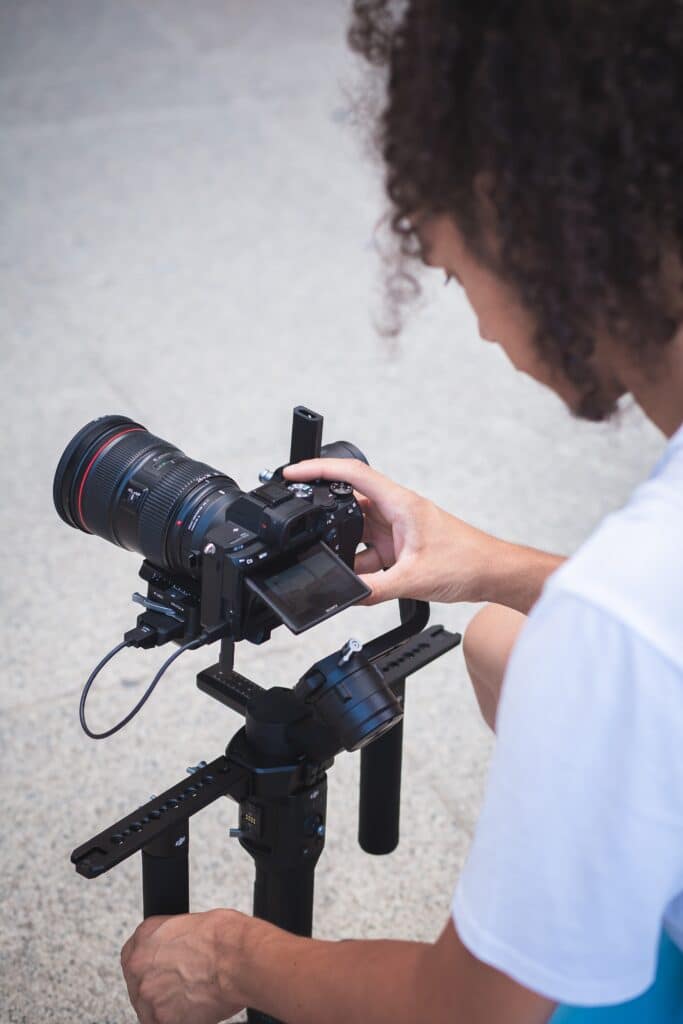Style and Accessibility
This last section is about the style choices and accessibility options available for the content you create. Style choices include editing and production techniques to influence the audience’s emotions in some way or another. It’s what draws people into your content. Additionally, accessibility grants access to a wider audience. This could be as simple as adding subtitles to your work or something more complicated like avoiding tones and shades that are difficult for color-blind people to discern from other colors.
12. Captions
Captions are a great way to make your content accessible for the hearing impaired, or anyone else who doesn’t want to listen to the audio. Moreover, it helps other people to better understand the audio for easier comprehension. Consider adding captions or having a version of your project with captions.
13. Colors and color blindness
Red-Green color blind is by far the most common type of color blindness. So, avoid shades of red or green that are faintly colored, especially if you’re doing that with any text on your set. There are tools out there online for you to guide your journey on accessibility.
14. Strobe effects, flashing lights, and seizures
Rapidly flickering lights can be difficult or just plain annoying for some people to watch. But, for others, it’s the difference between an epileptic episode and enjoying a video. If you do choose to have flashing lights in your project, put a seizure warning for anyone viewing who might be prone to epileptic seizures.
15. Audio accessibility
Even with good audio quality, there will sometimes be significant jumps in the audio input. If anyone is watching your video with headphones in and the audio suddenly spikes really high, it coil put them off your video together, or worse, give them hearing damage. So, carefully review your levels even if they are mostly where you want them to be.
16. ASL
Like subtitles, ASL will open up your content to new audiences, namely, deaf people. While this will depend on your production budget, it’s good to plan whether or not you will incorporate ASL into your media. This will likely involve hiring an ASL interpreter.
17. Audio descriptions
Like ASL, audio descriptions will make your content more accessible. This aids those who have difficulty in discerning visual information like blind people or people who are otherwise visually impaired. Again, this will likely involve you hiring someone to do a voiceover describing what is happening from scene to scene, and an entire additional planning process.
18. Transcriptions
Transcriptions help make the production process more efficient and accessible by correlating audio and/ or video information at specific points of the media time stamped into a sort of script. While fictional films will probably already have a script, non-fictional media like video journalism is more of a free-form recording of a conversation that
19. Practice
Like any skill, videography takes practice. Very few people are talented and lucky enough to be great at something the second they start doing it. So, be patient with yourself and stick to the plan. Everyone wants to finish the race before they start. It’s more of a marathon than a sprint anyway. You don’t need to be the first one across the finish line, just getting there is good enough for most people. Having a beginner’s mindset like this will help you to roll with the punches and avoid burnout.
20. Have fun
While there is absolutely no shortage of planning, preparation, and work to produce the video content of your dreams, it’s important to remind yourself to have fun with whatever you are working on as much as possible. If you feel frustrated, burnt out, or bitter about a project that you’re working on, chances are it might translate into your project. If you feel that way, it’s probably best to take some time away from the project until you feel better about completing the work, rather than sending in something half-baked.
Hopefully, you now have a better idea about all of the moving parts behind making an audio-video project come to life. If you haven’t already (and maybe even giving it a second glance if you already have) check out the Format portfolio builder! It’s an easy and effective way to display your best work, the work that you’ve worked so hard on. Since you are spending countless hours reviewing footage and articles to make sure your skills are up to date and you are using the best practices, it would be a waste of your time and expertise to not show it to the world, and Format’s portfolio builder can surely help you achieve that goal.
